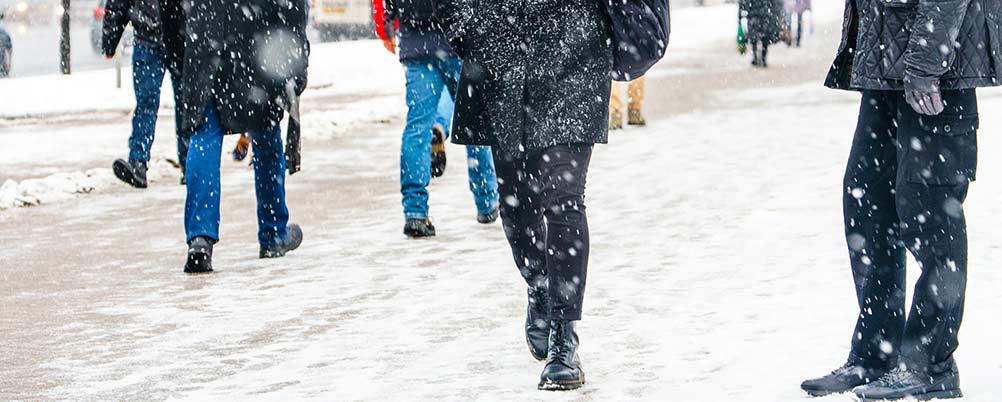Winter is quite possibly the most dangerous season of the year. Ice and snow cause sidewalks and roads to become slick, increasing the risk of serious accidents. Indoor floors can also become slippery when winter weather is tracked inside, particularly inside entryways and outside elevator doors.
Safety must be a top priority for all Connecticut residents to prevent injuries from winter hazards this season. No matter how you choose to travel, here are some safety tips to keep in mind.
Winter Car Accidents
Car accidents notoriously increase in the winter months. According to the Federal Highway Administration, at least 24 percent of car accidents nationwide result from winter weather-related factors. Among these accidents, more than 1,300 result in fatalities and over 116,800 in various injuries.
Roads become even more dangerous during periods of active precipitation. At least 15 percent of all winter weather-related car accidents occur during active sleet or snowfall. These accidents result in nearly 76,000 injuries and 900 fatalities every year.
Types of Winter Weather
Several types of winter weather can increase a driver's risk of an accident. The National Weather Service provides the following classifications to help drivers understand each one and prepare accordingly:
- Freezing Rain- rain that occurs when temperatures are below freezing, causing raindrops to freeze on contact with the ground and other surfaces.
- Blizzard- a storm involving heavy falling snow with winds at least 35 mph and visibility is reduced to a quarter of a mile or less; lasts for at least three hours and can result in quick snow accumulation.
- Snow Squall- an intense period of moderate to heavy snow, often including gusty winds with reduced visibility and ‘whiteout’ conditions.
- Sleet- rain/melted snow that refreezes when it hits the ground, leading to icy roads and sidewalks.
- Wind Chill- the temperature that your body feels outside when the wind is factored in.
Common Causes of Winter Car Accidents
When sudden snowstorms blow in, winter weather-related car accidents can happen quickly, sometimes without warning. Connecticut drivers should be aware of three common causes of winter car accidents to help prevent accidents this season.
Slippery Roads
Cold temperatures cause all types of precipitation on the road to freeze. It only takes minutes for icy patches to accumulate. These conditions make it difficult for tires to gain traction and for drivers to control their vehicles when they start to slide. Rear-end collisions, sideswipes, and accidents at intersections are common types of car accidents resulting from slippery road conditions.
Black ice is an especially dangerous road condition that leads to thousands of accidents every winter. These practically thin sheets of ice are almost impossible to detect, especially when driving at night. Black ice results in vehicles spinning out of control suddenly, often leading to catastrophic injuries and multi-vehicle accidents.
Drivers must continuously operate their vehicles with care when winter weather strikes. To start, AAA suggests keeping your speeds low and leaving plenty of space between cars. Stay in your lane and plan ahead for entering and exiting off highways. If the weather forecast looks dangerous, don’t take a chance on the road. Sometimes, no matter how carefully you drive, winter storms make it impossible to navigate roads safely.
Do not panic if a winter storm hits while you are already driving. AAA recommends the following:
- Slow down immediately and stay alert.
- Keep a close eye on the road surface to avoid sudden icy patches and snow build-up.
- Drive defensively and watch out for vehicles around you who may swerve into your lane.
- Increase the distance between you and the vehicles in front of you.
- Put on your emergency lights to keep vehicles behind you at bay.
Poor Visibility
Active winter precipitation, such as sleet and snow can significantly reduce a driver’s visibility. The term ‘whiteout’ refers to heavy periods of snow where drivers can see nothing in front of them but flakes and white haze. Different types of winter storms provide various levels of visibility, but all can lead to accidents when drivers cannot see the road in front of them.
Drivers with reduced visibility cannot stop for other vehicles, pedestrians, or stationary road features such as partitions, guardrails, bridges, and street signs. It takes a car ten times longer to come to a complete stop on snowy and slippery roads. But without adequate reaction time to spot hazards ahead of time, accidents are bound to occur.
Nighttime driving, though already hazardous, can become especially deadly when winter weather strikes. The National Safety Council reports that fatal road accidents are three times higher at night than during the day. During the winter months, these risks climb even higher.
Slowing down is key when drivers are hit with sudden snow squalls and storms that cause snow to drift. With practically zero visibility in whiteout conditions, AAA advises that drivers exit the road as soon as safely possible. If you must pull over to the side, make sure to do so on the shoulder and not the median. Keep your emergency lights on and stay as visible as possible to other vehicles around you.
Vehicle Condition
Temperatures that drop below freezing can cause vehicle trouble almost instantly. The most common issues drivers will face in the winter include:
Tire Maintenance
Low tire pressure is common when temperatures plummet and put tires at risk for popping. Additionally, worn-out tires will have poor traction on the road and cause vehicles to slide and drift on ice. If your tires need to be replaced, now is the time to do it. Other steps you can take to keep your tires in working condition include checking your tire pressure frequently and rotating your tires according to your manufacturer's recommendations to prevent bald spots.
Windshield Wipers
If done incorrectly, clearing ice off of your windshield wipers can damage the blades. Damaged wipers will not clear away snow and rain effectively, further reducing visibility on the road. When winter weather is in the forecast, flip your wipers up to prevent them from freezing to the windshield. If you forget, turn on your heat to help defrost the wipers before you start to scrap to allow some of the ice holding the wiper in place to melt. If you do find your wipers are damaged, replace them immediately.
Defroster Fans
Defective defrosting fans can cause fog on your windshield and reduce your visibility on the road. Make sure your fans are in good working condition in both the front and back of your vehicle.
Headlights
Headlights are essential for navigating snowy and dark roads. Lights that are too dim or covered with ice and snow will cause drivers to miss hazards. Always make sure your lights are working before you leave your home. When cleaning off your car, make sure to clear all ice and snow away to prevent your lights from appearing dull.
For more information about driving in winter weather, visit AAA’s website for more tips.

Winter Slip, Trip, and Fall Accidents
Slip, trip, and fall accidents are frequent during the winter months. Ice and snow make sidewalks treacherous to navigate on foot, and the inside of buildings become a sloppy mess when the weather is tracked indoors. Some of these accidents result in serious and disabling injuries; sadly, the worst fall injuries can have fatal consequences.
Seasonal hazards that increase slip, trip, and fall accidents in the winter months include unplowed streets and walkways, unsalted surfaces, and wet surfaces. Injuries resulting in these hazards often include:
- Bone fractures
- Traumatic head injuries
- Spinal cord damage
- Soft tissues injuries
- Nerve damage
Unfortunately, pedestrians cannot control the walking conditions of public streets and sidewalks. When ice and snow are present, it is up to all residents to try their best to stay safe. The Occupational Safety and Health Administration (O.S.H.A.) and Mayo Clinic recommend taking the following steps to stay safe when traveling by foot this winter:
Winter Footwear
Pedestrians should wear winter boots or other footwear specifically manufactured for walking on ice and snow. Footwear with insulation to keep feet warm and rubber soles providing traction on slippery surfaces are recommended. You can also purchase rubber treads to make your everyday shoes more adaptable to slippery conditions.
Short Steps
It’s not always easy to spot an icy patch until your foot starts to slip. Taking small steps allows you to react quicker to slippery spots and redirect your foot before you fall. You may feel silly, but small steps could save you a lot of pain in the future.
Go Slow
Rushing on ice and snow will only cause more falls. Never run on the ice. Plan ahead and leave early when you have somewhere to be in the winter. Take your time and pay attention to the hazards surrounding you to help prevent accidents.
Use Assistance
When walking up or down stairs or ramps, make sure to use available handrails to help you. If you require a walking stick, cane, or walker, the winter season is the time to use it.
Stay Inside
Don't risk it if there is no need to go anywhere during poor weather conditions. Ice and snow build up fast, and there are no guarantees that sidewalks will be clear where you are going. Stay indoors to stay safe.
While Connecticut does not have a statewide law regarding snow removal, each municipality may adopt its own laws requiring premise owners to clear ice and snow from walking surfaces. For more information on which laws your town requires, contact your local municipality.


